
Darlinghurst is an inner-city suburb in the eastern suburbs of Sydney, New South Wales, Australia. Darlinghurst is located immediately east of the Sydney central business district (CBD) and Hyde Park, within the local government area of the City of Sydney. It is often colloquially referred to as "Darlo".

Glebe is an inner-western suburb of Sydney in New South Wales. Glebe is located 3 kilometres (1.9 mi) southwest of the Sydney central business district and is part of the local government area of the City of Sydney, in the Inner West region.

Haberfield is a suburb in the Inner West of Sydney, in the state of New South Wales, Australia. Haberfield is located 6.5 kilometres west of the Sydney central business district in the local government area of the Inner West Council.

Potts Point is a small and densely populated suburb in inner-city Sydney, New South Wales, Australia. Potts Point is located 2 kilometres (1.2 mi) east of the Sydney central business district and is part of the local government area of the City of Sydney.
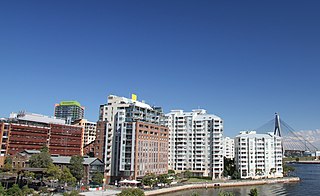
Pyrmont is an inner-city suburb of Sydney, in the state of New South Wales, Australia 2 kilometres south-west of the Sydney central business district in the local government area of the City of Sydney. It is also part of the Darling Harbour region. As of 2011, it is Australia's most densely populated suburb.

Paddington is an upscale Eastern Suburb of Sydney, in the state of New South Wales, Australia. Located 3 kilometres (1.9 mi) east of the Sydney central business district, Paddington lies across two local government areas. The portion south of Oxford Street lies within the City of Sydney, while the portion north of Oxford Street lies within the Municipality of Woollahra. It is often colloquially referred to as "Paddo".

Thomas Sutcliffe Mort was an Australian industrialist who improved the refrigeration of meat. He was renowned for speculation in the local pastoral industry as well as industrial activities such as his Ice-Works in Sydney's Darling Harbour and dry dock and engineering works at Balmain.

Edgecliff is a small suburb in the Eastern Suburbs of Sydney, in the state of New South Wales, Australia. Edgecliff is located 4 kilometres east of the Sydney central business district, in the local government area of the Municipality of Woollahra. The postcode is 2027.
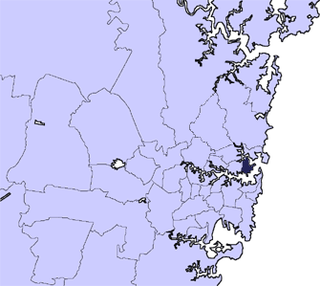
Mosman Council is a local government area on the Lower North Shore of Sydney, New South Wales, Australia.
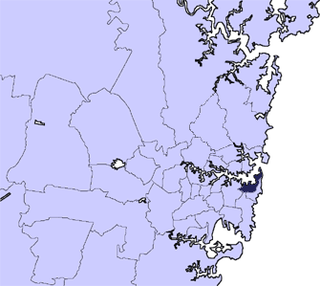
Woollahra Municipal Council is a local government area in the eastern suburbs of Sydney, in the state of New South Wales, Australia. Woollahra is bounded by Sydney Harbour in the north, Waverley Council in the east, Randwick City in the south and the City of Sydney in the west.

Rushcutters Bay is a harbourside inner-east suburb of Sydney, in the state of New South Wales, Australia 3 kilometres east of the Sydney central business district, in the local government area of the City of Sydney.

Point Piper is a small, harbourside eastern suburb of Sydney, in the state of New South Wales, Australia, 6 kilometres (4 mi) east of the Sydney CBD, in the local government area known as the Municipality of Woollahra.

Elizabeth Bay is a harbourside inner city suburb in the Eastern suburbs of Sydney, in the state of New South Wales, Australia. Elizabeth Bay is located three kilometres east of the Sydney central business district and is part of the local government area of the City of Sydney.

Dawes Point is a suburb of the City of Sydney, in the state of New South Wales, Australia. Dawes Point is located on the north-western edge of the Sydney central business district, at the southern end of Sydney Harbour Bridge, adjacent to The Rocks. At times Dawes Point has been considered to be part of The Rocks, or known as West Rocks, part of Millers Point, or part of it known as Walsh Bay.
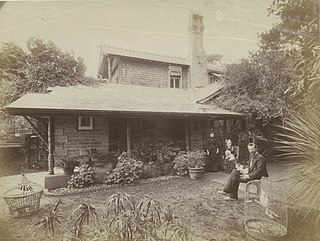
John Horbury Hunt, often referred to as Horbury Hunt, was a Canadian-born Australian architect who worked in Sydney and rural New South Wales from 1863.
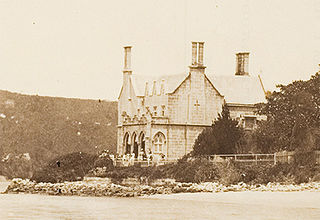
Carthona is a large Gothic Revival architecture style house situated at 5 Carthona Avenue, on a promontory of Darling Point, in Sydney, New South Wales, Australia. The mansion is listed by the New South Wales Heritage Council as a building of historical significance and is listed as being of local significance on the New South Wales Heritage Database.

Bishopscourt, Darling Point is a heritage-listed residence and former archbishop's residence at 11A Greenoaks Avenue, Darling Point, Sydney, Australia. It was designed by J. F. Hilly (1846), Edmund Blacket (1859) and Leslie Wilkinson (1935) and built from 1846 to 1849 by Thomas Woolley (1841); Thomas Sutcliffe Mort. It is also known as Bishopscourt and Greenoaks. Up until December 2015, the property was owned by the Anglican Diocese of Sydney; and is now privately owned. The property was added to the New South Wales State Heritage Register on 2 April 1999.

St Mark's Church is an active Anglican church in Darling Point, a suburb of Sydney, New South Wales, Australia. It is part of a significant local heritage group that includes the church, rectory, and adjacent cottage. The group forms part of a large collection of important to late 19th century buildings of considerable townscape, historic and cultural significance, including the former St Mark's Crescent School, St Mark's Cottage and Bishopscourt, formerly Greenoaks.

18–20a Munn Street is a heritage-listed row of terrace houses located at 18, 18a, 20, 20a Munn Street, in the inner city Sydney suburb of Millers Point in the City of Sydney local government area of New South Wales, Australia. It was added to the New South Wales State Heritage Register on 2 April 1999.
John Frederick Hilly was a surveyor and architect who designed commercial buildings, churches and houses in mid-nineteenth-century Sydney, New South Wales. He was born in Warwickshire and arrived in Australia in 1839. On 8 January 1842 Hilly married Ellen Morgan at Christ Church St Laurence in Sydney. Hilly Street in Mortlake, New South Wales, is named in his honour. Works attributed to Hilly include:
























